In the first half of our Top Ten Most Versatile EDH Cards of 2019, we addressed some honorable mentions of the set that worthy of mentioning, as well as counted down cards 10-6. Today, we’re looking at the remaining five cards and how they stack up to one another.
We all know why we’re here today, so let’s get right to it!
Number Five: Goreclaw, Terror of Qal Sisma
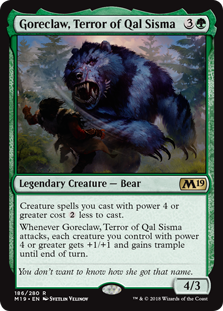 First off, can we just acknowledge how awesome the name Goreclaw is for a bear?
First off, can we just acknowledge how awesome the name Goreclaw is for a bear?
Since it was first spoiled, many Magic players have been excited over the prospect that one of the more classically iconic creature types finally got a legendary creature to call its own. People have been clammoring for a legendary bear for years now (it’s A Thing). Yet when the card finally was shown off, reaction among said community was split. For some, the mere existence of the Terror of Qal Sisma was enough to make them happy, giving them the ability to work on some thematic deck ideas – including bear-centric EDH decks. For others though, reception was a bit cooler since Goreclaw isn’t a bear ‘lord’ – a creature that overtly benefits other creatures of its type.
While we certainly can understand this discussion among the fans of bears, Goreclaw shouldn’t be discounted. In fact, in the realm of Commander, his presence can be down right, well, terrifying.
At a 4/3 for four mana, Goreclaw is already an on-par creature for its size and cost, and the single Green mana means she can be easily splashed into multicolor decks. But its two her abilities more than make up for the modest frame. First, Goreclaw reduces every creature you cast of power 4 or greater by two mana, a throwback to the Temur wedge’s Ferocious keyword. In many Limited or Constructed formats this might not be super exciting, but in Commander the possibilities alone are amazing to consider.
Just ponder for a second how many creatures you have of power 4 or greater in any given EDH deck.
In many cases, Goreclaw simply being on the battlefield could accelerate the speed of the deck substantially, getting out giant stompy creatures faster. For many who run creature-heavy decks, that first ability by itself is enough to have them wanting to bear her presence.
But wait, there’s more! Because Goreclaw’s second ability, while a little more situational, is no less scary when timed right. It states that she goes all Stampede Driver when she attacks, giving every creature of power 4 or greater (the same ones she makes cheaper to enter the battlefield) +1/+1 and Trample for the turn. In a deck that’s likely already going to benefit from having big splashy creatures coming out quicker, to then be able to attack with Trample shortly thereafter is like icing on a very hairy cake. Sure Goreclaw has to attack to make use of it, but this also makes her a 5/4 as well, making her that much harder to stop.
The amount of swing Goreclaw is able to make in a game merely by existing – all for just four mana – is far too useful to ignore in longer games like Commander where larger creatures are more common and more plentiful. Whether bear fans like it or not in this case is immaterial, because Goreclaw’s versatility and board advantage is going to find a quick home in many EDH decks all the same.
Number Four: Cleansing Nova
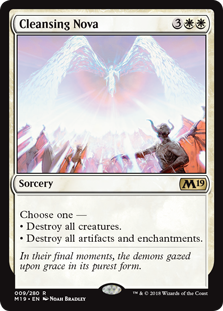 Just about every set nowadays has some form of mass board wipe, the effects of which range depending on the needs of the set itself, the needs of Standard at the time, and the desire by Wizards R&D to create clever new iterations of the same concept over and over again.
Just about every set nowadays has some form of mass board wipe, the effects of which range depending on the needs of the set itself, the needs of Standard at the time, and the desire by Wizards R&D to create clever new iterations of the same concept over and over again.
Because this is a core set, however, such effects tend to be far more on the nose than a typical expansion. None of that is more obvious than this set’s White board wipe, Cleansing Nova.
Unlike many other card subthemes, however, that isn’t necessarily a bad thing. In the case of Cleansing Nova, it’s actually incredibly advantageous to consider using in your deck, even compared to similar cards from the past.
For five mana Cleansing Nova allows you to decide the form of your destruction, either wreaking havoc on the battlefield by destroying all creatures or artifacts and enchantments. Although it’s not the most creative card endeavor (it’s basically a stapled together combination of a fractionally more expensive Day of Judgment and Purify), blending two highly versatile cards into one utility-based board wipe for approximately the same mana cost is anything but useless in a format that’s always on the lookout for ways to consolidate every available card slot.
Cleansing Nova isn’t quite as granular as the popular EDH stalwart Austere Command , but this is one board wipe that could easily enter similar rotation thanks to a combination of it being comparatively one mana cheaper and much easier to acquire than Austere while providing more opportunities than a mere Day of Judgment. (It also still gives you more control over what you wipe away compared to, say, the much less discriminating Planar Cleansing. Cleansing Nova is an excellent addition to this family of cards and manages to stand on similar ground as some of its commonly used predecessors.
Number Three: Vaevictis Asmadi, the Dire
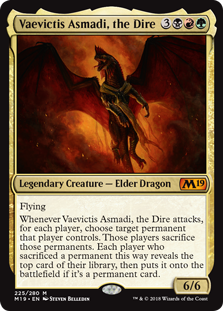
Core Set 2019 is memorable in a number of ways. It’s the first new core set in several years. It has an abundance of planeswalkers. And it’s a deck whose loose storyline threads all revolve around the current Big Bad of the game, Nicol Bolas, the ancient elder dragon planeswalker whose machinations and thirst for more power have crippled planes and planeswalkers for a long, long time. The set provides some excellent history to Nicol Bolas by calling back many of the names and faces that have been in his orbit over the years. None of these callbacks elicited more excitement with the veteran Magic crowd, however, than by introducing new versions of the classic Elder Dragon Five from the Legends set. Since their creation, these five dragons launched a series of stories, conversations, and debates that have gone on almost as long as Magic itself. Just the names themselves have reached almost mythical status, partially because of how long ago they were created, but also because it’s hard to know exactly which pieces of their lore are considered canon due to the availability (or lack thereof) of the original comics and stories. Plus there’s been some periodic revisionism by Wizards itself.
While most of the attention in this set will be focused on the most famous of the Five, Nicol Bolas and his fancy new ascension-flavored planeswalker flip card, the most worthwhile of the bunch from a versatility standpoint is actually the very-slightly-less disgruntled Vaevictis Asmadi.
Make no mistake: you will see an abundance of new Asmadi decks pop up as the weeks and months roll by. Which is understandable, as not only are all of these new dragon legends intended to make good Commanders, this one in particular packs a highly potent punch in multiplayer games.
Right on par with most Jund-colored dragons, Vaevictis Asmadi is well costed for its size, a 6/6 Flyer for six mana. That alone provides a decent return on investment. Vaevictis’s attack trigger, though, is something else entirely. It states that when they attack, for each player, you force them to sacrifice a targetable permanent on their board. Creatures, enchantments, planeswalkers, anything indestructible. Just by attacking. Then, in typical Red chaos fashion, it attempts to replace that card by having each person reveal the top card of their deck. If it’s a permanent they can drop it onto the battlefield. If it’s not, they get nothing and everyone now gets to know what their next card draw will be.
Just. By. Attacking.
Sure, Vaevictis requires three different colors to use, their trigger affects you as well, and there is always the possibility that by removing one permanent you may be giving your opponent something even better. But since you’re likely going to be targeting the most powerful card on their battlefields – and the most expendable on your own – it’s almost always going to be worth the risk. For every time you may give them a better option, there are going to be far more where you’ve significantly stymied their actions. In your own case, you may even benefit.
Honestly, the biggest challenge is likely going to be keeping it alive, because most of your opponents aren’t going to want to be on the receiving end of that trigger attack too many times, so be aware that it’s likely to become a common removal target.
That said, Vaevictis is both an excellent EDH card, as well as a Commander choice, due to the sheer power of how quickly it can reshape the board and alter the balance of power. It allows you the ability to remove multiple problematic cards from the battlefield at the same time while also forcing your opponents to contend with a giant flying dragon.
And unlike Nicol Bolas, it doesn’t cost you 11 mana before it starts doing something cool. How’s that for sibling rivalry?
Number Two: Tezzeret, Artifice Master
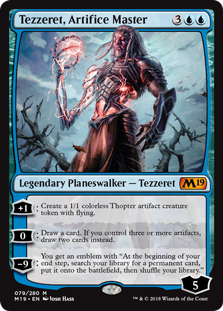
Planeswalkers have a precarious lifespan in the world of EDH. Most of the time they don’t stay on the board for lengthy periods of time unless they’re either well protected or the bulk of their effects are rather innocuous, their presence not deemed worthy of immediately drawing the ire of other players. Which makes sense. Planeswalkers by their nature are all up-side cards, and top-tier walkers can be miniature powerhouses unto themselves through the right combination of effects and mana costs.
That doesn’t immediately mean that every planeswalker is going to find an easy home in Commander. Rather, it’s more about finding those that have the right qualities that make them worth adding to your deck. Many of the tournament-sought planeswalkers, for instance, either cost less than five mana and / or have a means of self-preservation. Those best suited for Commander on the other hand are usually those that provide the most utility to the deck they’re in. Since you’re investing a card slot for what’s more or less an enchantment that can be attacked to death, EDH players want to ensure that the planeswalkers they use are going to be worth the effort of keeping around.
Which is why the newest Tezzeret is a bit of an odd one, because it has traits that both camps are going to enjoy.
For starters, Tezzeret, Artifice Master enters with a sizable five loyalty, ensuring that he can’t be quickly picked off by a couple small creature attacks. Second, his defense is immediately bolstered by his +1 ability, creating a 1/1 Flying artifact creature that can help stand in the way of both ground and air attacks if need be. Simply having these thopter tokens also directly ties into his second ability, a +0 that lets you draw one card – but also second card if you have at least three artifacts out. Drawing two cards each turn for free is absolutely huge in terms of card and tempo advantage, and the impact of those first two options shouldn’t be undersold. Which is why although Tezzeret costs five mana to cast, many tournament decks are still eyeing him with great interest due to the kind of advantages he can provide.
Finally, Tezzeret’s ultimate is down right scary, providing a free permanent from your deck each turn, allowing you to get whatever answer or card advantage you desire at that moment. Now, the likelihood that Tezzeret will be able to reach that point in an EDH game without some kind of shenanigans or player inaction (in which case blame on them). This is fine. Given how useful the first two abilities are in general he already is worth considering, enough so that it is those two abilities alone which are why he earns the runner-up spot on this list.
Besides, not pursuing that Planar Bridge emblem option could be for the best in your Commander game unless you can try to end things quickly thereafter. Because should you be able to pull off that ultimate, expect the table to turn against you in a hurry.
Yes, Tezzeret will be a target for removal, as many of the best planeswalkers are, but the card and creature advantage it provides in the meantime will be well worth the tradeoff.
Number One: Chaos Wand
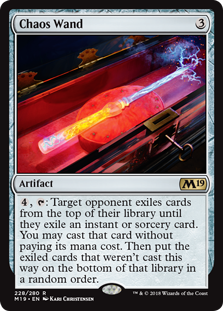
For all outward appearances, Chaos Wand is likely not the card most people are going to consider when they think about Core 2019 and EDH potential.
This will be at their peril.
Chaos Wand admittedly isn’t as inherently powerful or individually resonant as many other cards on this list – it’s not the kind of card that is going to scare opponents or give you immediate table advantage as soon as it hits the board. Nor is it guaranteed to fuel deck synergy or game-altering combos. What it is going to do, however, is provide the substantial and repeatable means of doing something most casual Commander players hate: having their opponent use their own resources against them.
With a cheap three mana cast and a marginal four mana activation, Chaos Wand is a colorless Telemin Performance for spells. Which may not sound scary, until you sit back and consider the sheer volume of powerful instants and sorceries a typical EDH deck comes with. Massive damage spells and board wipes. One-sided bounces and targeted removal. Cards providing incredible combat boosts, card draws, mana acceleration, and all manner of ways to cripple a meddlesome opponent. In effect, everything they have in their deck to leverage at you, you now can use to your advantage instead. With every activation, you create card and resource advantage. For just four mana.
While it is true that the outcome of what you will find is random and can’t be predicted, odds incredibly high you’ll hit something worthwhile with nearly every activation. The fact that its colorless means it can be added to every deck, and its low price point means that unlike several of the cards highlighted in this two-part series, it’s not going to hurt the bank tracking a copy down.
Plus, although it may seem counter-intuitive, the randomness factor adds to the card’s overall appeal. After all, Commander games are ultimately about having fun a casual manner, and this magic wand conjures up that sentiment with ease. Pool, all of these factors together and it becomes fairly apparent why it earned the top spot of the new cards from Core Set 2019.
![]()
Would these cards have been on your own top ten? Tell us over on our social media!
Do you have a particular Commander card to suggest for us to shine a future Spotlight on? You can send suggestions to ryan@cardboardrepublic.com
